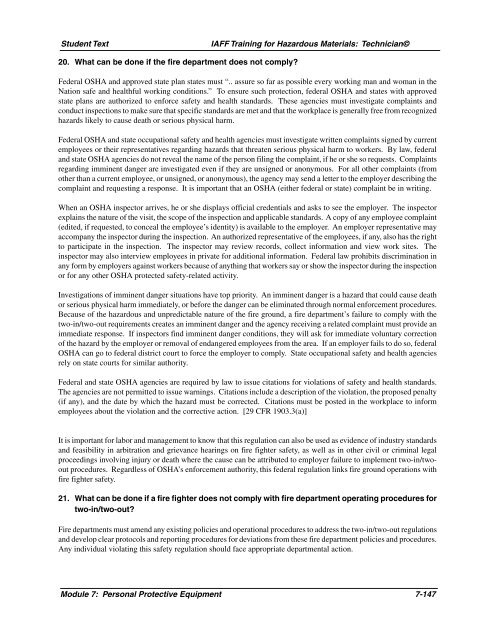Module 7 - IAFF
Module 7 - IAFF
Module 7 - IAFF
Create successful ePaper yourself
Turn your PDF publications into a flip-book with our unique Google optimized e-Paper software.
Student Text <strong>IAFF</strong> Training for Hazardous Materials: Technician©<br />
20. What can be done if the fire department does not comply?<br />
Federal OSHA and approved state plan states must “.. assure so far as possible every working man and woman in the<br />
Nation safe and healthful working conditions.” To ensure such protection, federal OSHA and states with approved<br />
state plans are authorized to enforce safety and health standards. These agencies must investigate complaints and<br />
conduct inspections to make sure that specific standards are met and that the workplace is generally free from recognized<br />
hazards likely to cause death or serious physical harm.<br />
Federal OSHA and state occupational safety and health agencies must investigate written complaints signed by current<br />
employees or their representatives regarding hazards that threaten serious physical harm to workers. By law, federal<br />
and state OSHA agencies do not reveal the name of the person filing the complaint, if he or she so requests. Complaints<br />
regarding imminent danger are investigated even if they are unsigned or anonymous. For all other complaints (from<br />
other than a current employee, or unsigned, or anonymous), the agency may send a letter to the employer describing the<br />
complaint and requesting a response. It is important that an OSHA (either federal or state) complaint be in writing.<br />
When an OSHA inspector arrives, he or she displays official credentials and asks to see the employer. The inspector<br />
explains the nature of the visit, the scope of the inspection and applicable standards. A copy of any employee complaint<br />
(edited, if requested, to conceal the employee’s identity) is available to the employer. An employer representative may<br />
accompany the inspector during the inspection. An authorized representative of the employees, if any, also has the right<br />
to participate in the inspection. The inspector may review records, collect information and view work sites. The<br />
inspector may also interview employees in private for additional information. Federal law prohibits discrimination in<br />
any form by employers against workers because of anything that workers say or show the inspector during the inspection<br />
or for any other OSHA protected safety-related activity.<br />
Investigations of imminent danger situations have top priority. An imminent danger is a hazard that could cause death<br />
or serious physical harm immediately, or before the danger can be eliminated through normal enforcement procedures.<br />
Because of the hazardous and unpredictable nature of the fire ground, a fire department’s failure to comply with the<br />
two-in/two-out requirements creates an imminent danger and the agency receiving a related complaint must provide an<br />
immediate response. If inspectors find imminent danger conditions, they will ask for immediate voluntary correction<br />
of the hazard by the employer or removal of endangered employees from the area. If an employer fails to do so, federal<br />
OSHA can go to federal district court to force the employer to comply. State occupational safety and health agencies<br />
rely on state courts for similar authority.<br />
Federal and state OSHA agencies are required by law to issue citations for violations of safety and health standards.<br />
The agencies are not permitted to issue warnings. Citations include a description of the violation, the proposed penalty<br />
(if any), and the date by which the hazard must be corrected. Citations must be posted in the workplace to inform<br />
employees about the violation and the corrective action. [29 CFR 1903.3(a)]<br />
It is important for labor and management to know that this regulation can also be used as evidence of industry standards<br />
and feasibility in arbitration and grievance hearings on fire fighter safety, as well as in other civil or criminal legal<br />
proceedings involving injury or death where the cause can be attributed to employer failure to implement two-in/twoout<br />
procedures. Regardless of OSHA’s enforcement authority, this federal regulation links fire ground operations with<br />
fire fighter safety.<br />
21. What can be done if a fire fighter does not comply with fire department operating procedures for<br />
two-in/two-out?<br />
Fire departments must amend any existing policies and operational procedures to address the two-in/two-out regulations<br />
and develop clear protocols and reporting procedures for deviations from these fire department policies and procedures.<br />
Any individual violating this safety regulation should face appropriate departmental action.<br />
<strong>Module</strong> 7: Personal Protective Equipment 7-147
















